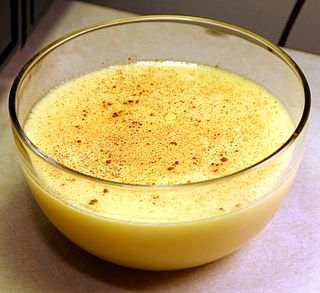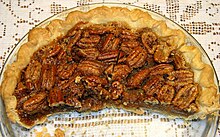
Dessert is a course that concludes a meal. The course consists of sweet foods, such as cake, biscuit, ice cream and possibly a beverage such as dessert wine and liqueur. Some cultures sweeten foods that are more commonly savory to create desserts. In some parts of the world there is no tradition of a dessert course to conclude a meal.

Cake is a flour confection made from flour, sugar, and other ingredients and is usually baked. In their oldest forms, cakes were modifications of bread, but cakes now cover a wide range of preparations that can be simple or elaborate and which share features with desserts such as pastries, meringues, custards, and pies.

Custard is a variety of culinary preparations based on sweetened milk, cheese, or cream cooked with egg or egg yolk to thicken it, and sometimes also flour, corn starch, or gelatin. Depending on the recipe, custard may vary in consistency from a thin pouring sauce to the thick pastry cream used to fill éclairs. The most common custards are used in custard desserts or dessert sauces and typically include sugar and vanilla; however, savory custards are also found, e.g., in quiche.

Corn syrup is a food syrup which is made from the starch of corn/maize and contains varying amounts of sugars: glucose, maltose and higher oligosaccharides, depending on the grade. Corn syrup is used in foods to soften texture, add volume, prevent crystallization of sugar, and enhance flavor. It can be processed into high-fructose corn syrup (HFCS) by using the enzyme D-xylose isomerase to convert a large proportion of its glucose into sweeter fructose.

Pralines are confections containing nuts – usually almonds, pecans and hazelnuts – and sugar. Cream is a common third ingredient.

A butter tart is a type of small pastry tart highly regarded in Canadian cuisine. The sweet tart consists of a filling of butter, sugar, syrup, and egg, baked in a pastry shell until the filling is semi-solid with a crunchy top. The butter tart should not be confused with butter pie or with bread and butter pudding.

Chess pie is a dessert with a filling composed mainly of flour, butter, sugar, eggs, and sometimes milk, characteristic of Southern United States cuisine.

Caramel apples or toffee apples are whole apples covered in a layer of caramel. They are created by dipping or rolling apples-on-a-stick in hot caramel, sometimes then rolling them in nuts or other small savories or confections, and allowing them to cool. When these additional ingredients, such as nut toppings, are added, the caramel apple can be called a taffy apple.

Divinity is a nougat-like confection made with whipped egg white, corn syrup, and sugar. Optional ingredients such as flavors, chopped dried fruit and chopped nuts are frequently added. Replacing the sugar with brown sugar results in a related confection called "sea foam".

Treacle tart is a traditional British dessert. The earliest known recipe for the dessert is from English author Mary Jewry in her cookbooks from the late 19th century.

Peanut pie, sometimes called the "poor man's pecan pie", is a pie that is part of the cuisine of the Southern United States, in the Tidewater region, where peanuts are a common crop. It can be served as a kosher dessert. In North Carolina it was a standard dish to serve at family reunions or church events.
Cashew pie is a pie prepared with cashews as a primary ingredient. Whole or chopped cashews may be used, or both. It may be prepared with a sweet filling base prepared with corn syrup, sugar and eggs, similar to how pecan pie filling is prepared. It may be prepared using chocolate and fruits, such as raspberry, as an ingredient, and may be served topped with whipped cream or caramel. It may be served hot.

Walnut pie is a pie prepared with walnuts as a primary ingredient. Whole or chopped walnuts may be used, or both, and toasted walnuts may be used. It may be prepared as a cream pie, and may include maple syrup, molasses, and cinnamon as ingredients. It may be prepared with a sweet filling base prepared with corn syrup, sugar, and eggs, similar to pecan pie filling. Chocolate and honey may also be used. Walnut pie may be prepared using fruits, such as raisins, figs, plums, and cranberries, among others. Walnut pie may be served at room temperature or warmed. It may be topped with whipped cream or served à la Mode.
Pie in American cuisine has roots in English cuisine and has evolved over centuries to adapt to American cultural tastes and ingredients. The creation of flaky pie crust shortened with lard is credited to American innovation.















